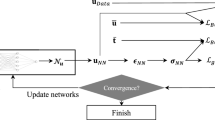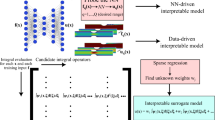Abstract
Nowadays, the study of neural networks is one of the most interesting research topics. In this article, we introduce a novel scheme based on Physics Informed Neural Network (PINN) for solving Fractional Differential Equations (FDEs) in terms of Caputo derivative. We use a trial solution based on the Theory of Functional Connection called the constrained expression to obtain the approximate solution. The training is proposed using the recently introduced average and subtraction-based optimizer algorithm. We implement the proposed algorithm to obtain the approximate solutions of single as well as a system of FDEs. The proposed scheme eliminates the primary drawbacks of the standard PINN. With our scheme, we overcome the choice of additional parameters that affect the convergence.










Similar content being viewed by others
Data availibility statement
The data used in this research is available/mentioned within the manuscript.
References
McCulloch WS, Pitts W (1943) A logical calculus of the ideas immanent in nervous activity. Bull Math Biophys 5(4):115–133
Lagaris IE, Likas A, Fotiadis DI (1998) Artificial neural networks for solving ordinary and partial differential equations. IEEE Trans Neural Networks 9(5):987–1000
Kilbas A, Srivastava HM, Trujillo JJ (2006) Theory and applications of fractional differential equations. Elsevier Science
Podlubny I (1998) Fractional differential equations: an introduction to fractional derivatives, fractional differential equations, to methods of their solution and some of their applications. Elsevier
Losada J, Nieto JJ (2015) Properties of a new fractional derivative without singular kernel. Progress Fract Differ Appl 1(2):87–92
Kumar P, Govindaraj V, Erturk VS, Abdellattif MH (2022) A study on the dynamics of alkali-silica chemical reaction by using Caputo fractional derivative. Pramana 96(3):1–19
Erturk VS, Ahmadkhanlu A, Kumar P, Govindaraj V (2022) Some novel mathematical analysis on a corneal shape model by using Caputo fractional derivative. Optik 261:169086
Erturk V S, Alomari A K, Kumar P, Murillo-Arcila M (2022) Analytic solution for the strongly nonlinear multi-order fractional version of a BVP occurring in chemical reactor theory. Discrete Dyn Nat Soc 2022
Kumar P, Erturk VS, Vellappandi M, Trinh H, Govindaraj V (2022) A study on the maize streak virus epidemic model by using optimized linearization-based predictor-corrector method in Caputo sense. Chaos Solitons Fractals 158:112067
Odibat Z, Erturk V S, Kumar P, Ben Makhlouf A, Govindaraj V (2022) An implementation of the generalized differential transform scheme for simulating impulsive fractional differential equations. Math Prob Eng 2022
Odibat Z, Erturk VS, Kumar P, Govindaraj V (2021) Dynamics of generalized Caputo type delay fractional differential equations using a modified Predictor-Corrector scheme. Phys Scr 96(12):125213
Kumar P, Erturk V S, Kumar A (2021) A new technique to solve generalized Caputo type fractional differential equations with the example of computer virus model. J Math Extension 15:1–23
Kumar P, Erturk V S, Murillo-Arcila M, Harley C (2022) Generalized forms of fractional Euler and Runge-Kutta methods using non-uniform grid. Int J Nonlinear Sci Numer Simul. https://doi.org/10.1515/ijnsns-2021-0278
Mall S, Chakraverty S (2018) Artificial neural network approach for solving fractional order initial value problems. arXiv preprint arXiv:1810.04992
Rostami F, Jafarian A (2018) A new artificial neural network structure for solving high-order linear fractional differential equations. Int J Comput Math 95(3):528–539
Pakdaman M, Ahmadian A, Effati S, Salahshour S, Baleanu D (2017) Solving differential equations of fractional order using an optimization technique based on training artificial neural network. Appl Math Comput 293:81–95
Effati S, Pakdaman M (2013) Optimal control problem via neural networks. Neural Comput Appl 23(7):2093–2100
Sabouri J, Effati S, Pakdaman M (2017) A neural network approach for solving a class of fractional optimal control problems. Neural Process Lett 45(1):59–74
Gao F, Dong Y, Chi C (2021) Solving fractional differential equations by using triangle neural network. J Funct Spaces 2021
Ibrahim RW (2013) The fractional differential polynomial neural network for approximation of functions. Entropy 15(10):4188–4198
Raja MAZ, Qureshi IM, Khan JA (2011) Swarm Intelligent optimized neural networks for solving fractional differential equations. Int J Innov Comput Inf Control 7(11):6301–6318
Almarashi A A (2012) Approximation solution of fractional partial differential equations by neural networks. Adv Num Anal 2012
Chaharborj SS, Chaharborj SS, Mahmoudi Y (2017) Study of fractional order integro-differential equations by using Chebyshev neural network. J Math Stat 13(1):1–13
McFall KS, Mahan JR (2009) Artificial neural network method for solution of boundary value problems with exact satisfaction of arbitrary boundary conditions. IEEE Trans Neural Networks 20(8):1221–1233
Viera-Martin E, Gómez-Aguilar J F, Solís-Pérez J E, Hernández-Pérez J A, Escobar-Jiménez R F (2022) Artificial neural networks: a practical review of applications involving fractional calculus. Eur Phys J Special Topics 231(10):2059–2095
Wang S, Teng Y, Perdikaris P (2021) Understanding and mitigating gradient flow pathologies in physics-informed neural networks. SIAM J Sci Comput 43(5):A3055–A3081
Huang GB, Zhu QY, Siew CK (2004) Extreme learning machine: a new learning scheme of feedforward neural networks. In 2004 IEEE international joint conference on neural networks (IEEE Cat. No. 04CH37541) Vol. 2, pp 985–990. Ieee
Wang J, Lu S, Wang SH, Zhang YD (2021) A review on extreme learning machine. Multimed Tools Appl 81:41611–41660
Yang Y, Hou M, Luo J (2018) A novel improved extreme learning machine algorithm in solving ordinary differential equations by Legendre neural network methods. Adv Differ Equ 2018(1):1–24
Li S, Liu G, Xiao S (2022) Extreme learning machine with kernels for solving elliptic partial differential equations. Cognitive Comput 15:413–428
Rathod N, Wankhade SB (2020) Improving extreme learning machine algorithm through optimization technique. In Advanced computing technologies and applications (pp 157–163). Springer, Singapore
Raissi M, Perdikaris P, Karniadakis GE (2019) Physics-informed neural networks: a deep learning framework for solving forward and inverse problems involving nonlinear partial differential equations. J Comput Phys 378:686–707
Schiassi E, Furfaro R, Leake C, De Florio M, Johnston H, Mortari D (2021) Extreme theory of functional connections: a fast physics-informed neural network method for solving ordinary and partial differential equations. Neurocomputing 457:334–356
Kharazmi E, Zhang Z, Karniadakis GE (2019) VPINNs: variational physics-informed neural networks for solving partial differential equations. arXiv preprint arXiv:1912.00873
Mertikopoulos P, Papadimitriou C, Piliouras G (2018) Cycles in adversarial regularized learning. In Proceedings of the Twenty-Ninth Annual ACM-SIAM Symposium on Discrete Algorithms (pp 2703–2717). Society for Industrial and Applied Mathematics
Mortari D (2017) The theory of connections: connecting points. Mathematics 5(4):57
De Florio M, Schiassi E, Furfaro R (2022) Physics-informed neural networks and functional interpolation for stiff chemical kinetics. Chaos 32(6):063107
Mortari D (2022) Using the theory of functional connections to solve boundary value Geodesic problems. Math Comput Appl 27(4):64
Coskun UH, Sel B, Plaster B (2022) Magnetic field mapping of inaccessible regions using physics-informed neural networks. Scientific Reports 12(1):12858
De Florio M, Schiassi E, Furfaro R, Ganapol BD, Mostacci D (2021) Solutions of Chandrasekhar’s basic problem in radiative transfer via theory of functional connections. J Quant Spectrosc Radiat Transfer 259:107384
Schiassi E, D’Ambrosio A, Drozd K, Curti F, Furfaro R (2022) Physics-informed neural networks for optimal planar orbit transfers. J Spacecr Rocket 59(3):834–849
Schiassi E, D’Ambrosio A, Scorsoglio A, Furfaro R, Curti F (2021) Class of optimal space guidance problems solved via indirect methods and physics-informed neural networks
Dehghani M, Hubálovský Š, Trojovský P (2022) A new optimization algorithm based on average and subtraction of the best and worst members of the population for solving various optimization problems. PeerJ Comput Sci 8:e910
Odibat Z, Shawagfeh N (2020) An optimized linearization-based predictor-corrector algorithm for the numerical simulation of nonlinear FDEs. Phys Scr 95(6):065202
Funding
Not applicable.
Author information
Authors and Affiliations
Contributions
SMS: conceptualization, visualization, software, resources, formal analysis, investigation, writing—original draft. PK: conceptualization, investigation, resources, visualization, writing—review and editing. VG: supervision, formal analysis, writing—review and editing.
Corresponding author
Ethics declarations
Conflict of interest
This work does not have any conflicts of interest.
Additional information
Publisher's Note
Springer Nature remains neutral with regard to jurisdictional claims in published maps and institutional affiliations.
Rights and permissions
Springer Nature or its licensor (e.g. a society or other partner) holds exclusive rights to this article under a publishing agreement with the author(s) or other rightsholder(s); author self-archiving of the accepted manuscript version of this article is solely governed by the terms of such publishing agreement and applicable law.
About this article
Cite this article
S M, S., Kumar, P. & Govindaraj, V. A novel optimization-based physics-informed neural network scheme for solving fractional differential equations. Engineering with Computers 40, 855–865 (2024). https://doi.org/10.1007/s00366-023-01830-x
Received:
Accepted:
Published:
Issue Date:
DOI: https://doi.org/10.1007/s00366-023-01830-x




